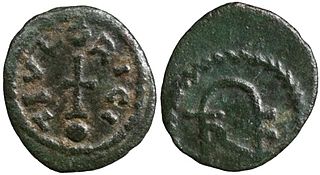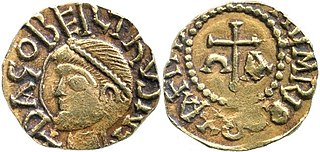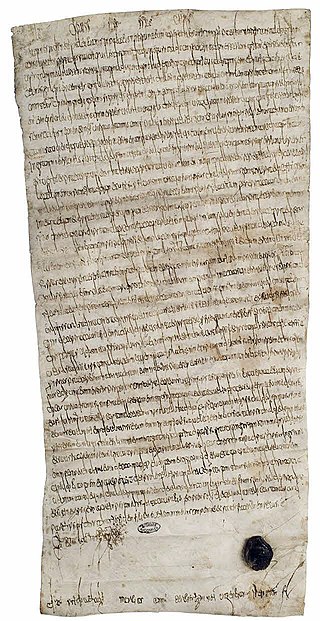
Theuderic I was the Merovingian king of Metz, Rheims, or Austrasia—as it is variously called—from 511 to 534.

Dagobert I was King of the Franks. He ruled Austrasia (623–634) and Neustria and Burgundy (629–639). He has been described as the last king of the Merovingian dynasty to wield real royal power. Dagobert was the first Frankish king to be buried in the royal tombs at the Basilica of Saint-Denis.

Burgundy is a historical territory and former administrative region and province of east-central France. The province was once home to the Dukes of Burgundy from the early 11th until the late 15th century. The capital, Dijon, was wealthy and powerful, being a major European centre of art and science, and of Western Monasticism. In early Modern Europe, Burgundy was a focal point of courtly culture that set the fashion for European royal houses and their court. The Duchy of Burgundy was a key in the transformation of the Middle Ages toward early modern Europe.

Clovis II was King of the Franks in Neustria and Burgundy, having succeeded his father Dagobert I in 639. His brother Sigebert III had been King of Austrasia since 634. He was initially under the regency of his mother Nanthild until her death in her early thirties in 642. Nanthild's death allowed Clovis to fall under the influence of the secular magnates, who reduced the royal power in their own favour; first Aega and then Erchinoald. The Burgundian mayor of the palace Flaochad used him to lure his rival, Willebad, to a battle in Autun, in which Willebad was killed.

The Duchy of Burgundy emerged in the 9th century as one of the successors of the ancient Kingdom of the Burgundians, which after its conquest in 532 had formed a constituent part of the Frankish Empire. Upon the 9th-century partitions, the French remnants of the Burgundian kingdom were reduced to a ducal rank by King Robert II of France in 1004. Robert II's son and heir, King Henry I of France, inherited the duchy but ceded it to his younger brother Robert in 1032.

Chlodomer, also spelled Clodomir or Clodomer was the second of the four sons of Clovis I, King of the Franks.

Autun is a subprefecture of the Saône-et-Loire department in the Bourgogne-Franche-Comté region of central-eastern France. It was founded during the Principate era of the early Roman Empire by Emperor Augustus as Augustodunum to give a Roman capital to the Gallic people Aedui, who had Bibracte as their political centre. In Roman times the city may have been home to 30,000 to 100,000 people, according to different estimates. Nowadays, the commune has a population of about 15,000.

Clovis IV was the king of the Franks from 690 or 691 until his death. If the brief reign of Clovis III (675) is ignored as a usurpation, then Clovis IV may be numbered Clovis III.

Theuderic III was King of the Franks. He ruled Neustria and Burgundy on two occasions, as well as Austrasia from 679 to his death in 691.
Brunhilda was queen consort of Austrasia, part of Francia, by marriage to the Merovingian king Sigebert I of Austrasia, and regent for her son, grandson and great-grandson.

Hunald I, also spelled Hunold, Hunoald, Hunuald or Chunoald, was the Duke of Aquitaine from 735 until 745. Although nominally he was an officer of the Merovingian kings of Francia, in practice Aquitaine was completely autonomous when he inherited it. His rule corresponds to the lowest point of the Merovingian monarchy, when the kingdom was in fact ruled by the mayors of the palace. Hunald was forced at the outset of his reign to accept the authority of the mayor of the palace Charles Martel, but he tried three times to throw it off in open revolt. He was unsuccessful, although he did manage to retain Aquitaine undiminished. In 745, he retired to a monastery, giving power to his son Waiofar. He later went to Rome, where he died during an attack on the city.

Leodegar of Poitiers was a martyred Burgundian Bishop of Autun. He was the son of Saint Sigrada and the brother of Saint Warinus.
Erchinoald succeeded Aega as the mayor of the palace of Neustria in 641 and succeeded Flaochad in Burgundy in 642 and remained such until his death in 658.

The Chronicle of Fredegar is the conventional title used for a 7th-century Frankish chronicle that was probably written in Burgundy. The author is unknown and the attribution to Fredegar dates only from the 16th century.
Flaochad was the mayor of the palace of Burgundy from 639 to 642. He was appointed by Nanthild, the queen mother, who gave him her niece, Ragnobert, in marriage. She called together the chief magnates and bishops of the kingdom at Orléans and he was acclaimed mayor.

Odette de Champdivers was the chief mistress of Charles VI of France. She was called la petite reine by Charles and contemporaries.
The Duchy of Alsace was a large political subdivision of the Frankish Empire during the last century and a half of Merovingian rule. It corresponded to the territory of Alsace and was carved out of southern Austrasia in the last decade of the reign of Dagobert I, probably to stabilise the southern reaches of Austrasia against Alemannia and Burgundy. By the late Middle Ages, the region was considered part of Swabia.
Waldalenus, or Wandalenus, dux in the region between the Alps and the Jura, in the Frankish Kingdom of Burgundy, was a Frankish magnate who served as mayor of the Austrasian palace at Metz from 581, during the minority of Childebert II.
The Battle of Autun was a pitched battle in 642 or 643, concluding a feud between Flaochad and Willebad, two magnates of the Merovingian kingdom of Burgundy. The battle is recounted in detail in the final chapter of the contemporary Chronicle of Fredegar and also in the biographies of saints Eligius of Noyon and Sigiramn. While Fredegar seems hostile to Willebad, the hagiographers are hostile to Flaochad. The anonymous author of Fredegar may have been an eyewitness.
Amalgar, also Amalgarius, was a Burgundian duke from the area around Dijon. He was also the proprietor of multiple monasteries, and was a progenitor of the Etichonid clan, from which the Habsburgs originate.